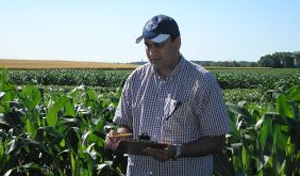The Environmental and Plant Biology Colloquium for Friday, Feb. 7, at 11:50 a.m. in Porter Hall 104, is presented by Dr. Rajandeep S. Sekhon, Assistant Scientist adn Postdoctoral Researcher in the Department of Agronomy at the University of Wisconsin, Madison. Dr. Morgan Vis is host.
Sekhon will discuss “An Integrated OMICS Approach to Harness Natural Variation Underlying Complex Traits in Maize.”
Abstract: I am fundamentally interested in employing next-generation genomic and transcriptomic approaches to elucidate genetic architecture of complex agronomic traits. My recent work has focused on developing comprehensive transcriptomic and genomic resources to drive the gene discovery pipeline in maize. This includes constructing a comprehensive developmental gene atlas based on microarrays and RNA-seq, and a diversity panel for genome-wide association studies. I am currently using this discovery framework to identify genetic elements underlying complex traits especially those relevant to plant biomass quality and yield in maize. One project, which I plan to pursue as an independent researcher, is to understand the role of source-sink interactions in regulation of senescence – a key determinant of photosynthetic assimilation. My recently published work established that, in certain maize genotypes, lack of the grain (a sink organ) results in pre-mature senescence that is preceded by hyper-accumulation of sugars in the leaf (a source organ). In follow-up unpublished work, I have examined natural genetic variation in the maize germplasm and identified significant marker-trait associations and quantitative trait loci underlying regulation of senescence via source-sink interaction. By integrating genomics, transcriptomics, and conventional genetic approaches, I have identified key targets for further research. Long-term goal of this project is delaying senescence by redirecting photoassimilates to a vegetative sink after grain fill thus improving energy density of stover for dual-purpose (grain/stover) crops. Additionally, I am also interested in employing the next-gen approaches to understand genetic architecture of stalk strength in maize.



















Comments